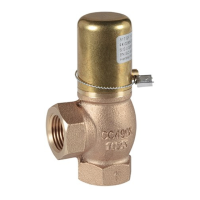Installation & Operation Manual
Proven Quality since 1892
ECON safety valves Fig. 512, 517 and 518 www.eriks.com
Rev. 1
9. Service and repair
All service and repair jobs should be carried out by authorized staff, using suitable tools and user
shall use valve parts, bolt and nut of the same size and material as the original one.
- all service and repair jobs should be carried out by authorized staff, using suitable tools
- only original valve parts may be used
- weld repair and drilling of the valve is forbidden.
- it is forbidden to replace the bolt, nut or packing when the valve is under pressure.
- after replacement, service or blow-off pressure adjustment, it is necessary to check the
safety valve on good functioning and tightness of all connections.
- service and/or repair on the safety valve may only be executed by approved workshops.
After repair, the safety valve must be set and sealed again!
- any warranty expires as soon as the seal has been removed.
10. Possible dangers
Leakage can cause danger of the safety and health of persons, animals and goods. Even when
the safety valve is functioning well, there can occur dangers which one must take into account.
Following dangers can occur:
- an over-pressure in the system is possible if the safety has not been sized according the
correct process data. Also the execution must correspond to the application.
- an over-pressure in the system is possible when the valve is blocked. This can be caused by
the formation of frost on the disc. Eventually, the valve must be protected against freezing.
Freezing can also be caused by expanding gasses at blow-off.
A blocked safety valve can also be caused by sticky media or crystallization; eventually other
safety devices (like bursting discs) can be used.
- when the safety valve blows off, hazardous, cold or hot medium can escape. The medium
must be discharged into a safe area
- injury by hot, cold or sharp parts. This can be avoided, by shielding or insulation.
- a dangerous noise level, when the medium blows off.
- chemical burns, injury or poisoning because of medium left behind in the valve. This can be
avoid by flushing the installation, before assembly.
11. Troubleshooting
It is essential that the safety regulations are observed when identifying the fault.

